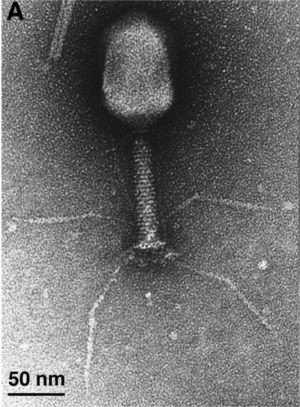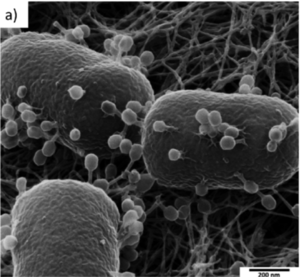T4 Bacteriophage

Classification
Viruses (Superkingdom); Duplodnaviria (clade); Heunggongvirae (kingdom); Uroviricota (phylum); Caudoviricetes (class); Straboviridae (family); Tevenvirinae (subfamily); Tequatrovirus(genus); Tequatrovirus T4(species)
You may notice the absence of a domain in the classification above. This is because bacteriophages, which are viruses, are not alive!
Species
|
NCBI: [https://www.ncbi.nlm.nih.gov/Taxonomy/Browser/wwwtax.cgi?mode=Info&id=1007084&lvl= 3&lin=f&keep=1&srchmode=1&unlock] |
Official name from Taxonomy Browser: Tequatrovirus T4
Current name: Escherichia phage T4
Commonly known as: Bacteriophage T4
Genome Structure
Describe the size and content of the genome. How many chromosomes? Circular or linear? Other interesting features? What is known about its sequence?
Cell Structure, Metabolism and Life Cycle

Interesting features of cell structure; how it gains energy; what important molecules it produces.
The T4 bacteriophage has the classic appearance that most people think of when they hear the term bacteriophage. If you were going to observe a T4 bacteriophage, you would notice two main parts of the virus' body; the head, and the tail. The head is comprised of an icosahedral (20 sided) capsid, that contains T4's _______ stranded _NA, and is the proximal part of the virus. The whole tail region has a few more parts, and is located distally to the icosahedral capsid. The proximal end of the tail is where the collar can be observed, and the distal end of the tail is where the baseplate can be observed. Extending laterally from the baseplate are six tail fibers that can be easily mistaken for legs. Despite being a virus, these tail fibers give T4 a very live appearance. Beneath the baseplate there is a spike that the bacteriophage uses to inject its genome into the host for replication.
The T4 bacteriophage is still quite smaller than its host, Escherichia coli. While Escherichia coli is a couple of micrometers, T4 is an entire order of magnitude smaller. The T4 bacteriophage is roughly ______ nM (nanometers) tall. In addition to being smaller than the host, T4 is also much more abundant than its host, outnumber E. coli nearly _____ to one.
Ecology and Pathogenesis
Habitat; symbiosis; biogeochemical significance; contributions to environment.
If relevant, how does this organism cause disease? Human, animal, plant hosts? Virulence
factors, as well as patient symptoms.
The term bacteriophage alone can tell you a bit about what T4 does. By breaking down the word to its prefix bacterio- and suffix -phage, you can determine that these organisms "eat" bacteria. Although they don't literally consume bacteria, bacteriophage T4's prey is eliminated as a result of the viral life cycle.
Bacteriophage T4 is a predator (and technically a parasite) of the bacteria Escherichia coli. It is technically considered a parasite because it is incapable of replicating or producing energy without a host cell.
Escherichia coli is the only prey/host species of this bacteriophage. Bacteriophages collectively may replicate by one of two cycles, the lytic cycle, or the lysogenic cycle. The T4 Bacteriophage strictly uses the lytic cycle. In the lytic cycle, T4 will land on the host cell's outer membrane and inject its genome through a surface receptor, such as a transport protein. When injecting the genome, the sheath contracts, making T4 appear shorter. After bacteriophage T4's genome has entered the host cell, it takes over control of the cell machinery that is normally involved in replication of host genetic material, then copying itself and producing enzymes to escape. Eventually T4's genetic material and cellular components are assembled into multiple entire copies of the virus, while lysins (a type of enzyme from bacteriophages) degrade the cell wall. This combination causes the host cell to burst, releasing all of the new replicates of T4.
Phage-host coevolution:
History & Significance
Bacteriophages were discovered just over a century ago, more than a decade before the discovery of penicillin. Even though penicillin took the spotlight in mainstream medicine, the medicinal potential of bacteriophages has not gone unrecognized. While antibiotics are fast acting, and easier to administer they don't have the same level of precision as a bacteriophage. Penicillin is a broad spectrum antibiotic, meaning it doesn't just kill pathogens but also kills harmless or even beneficial bacteria that are exposed to it. Meanwhile bacteriophages are host specific down to at least a species level. That means that a lytic bacteriophage can kill its host organism, while any other bacteria are simply bystanders and remain unharmed.
How to draw a T4 Bacteriophage
References
[Sample reference] [http://ijs.sgmjournals.org/cgi/reprint/50/2/489 Takai, K., Sugai, A., Itoh, T., and Horikoshi, K. "Palaeococcus ferrophilus gen. nov., sp. nov., a barophilic, hyperthermophilic archaeon from a deep-sea hydrothermal vent chimney". International Journal of Systematic and Evolutionary Microbiology. 2000. Volume 50. p. 489-500.]
NCBI NLM Taxonomy Browser. https://www.ncbi.nlm.nih.gov/Taxonomy/Browser/wwwtax.cgi
NIH NCBI Virus. https://www.ncbi.nlm.nih.gov/labs/virus/vssi/#/virus?SeqType_s=Nucleotide&VirusLineage_ss=Escherichia%20phage%20T4,%20taxid:2681598
Miller, Eric & Kutter, Elizabeth & Mosig, Gisela & Arisaka, Fumio & Kunisawa, Takashi & Rüger, Wolfgang. (2003). Bacteriophage T4 Genome. Microbiology and molecular biology reviews : MMBR. 67. 86-156, table of contents. 10.1128/MMBR.67.1.86-156.2003.
Schmidt, Matthias & Byrne, James & Maasilta, Ilari. (2021). Bio-imaging with the helium-ion microscope: A review. Beilstein Journal of Nanotechnology. 12. 1-23. 10.3762/bjnano.12.1.
Author
Page authored by Jake Delaney, student of Prof. Bradley Tolar at UNC Wilmington.
